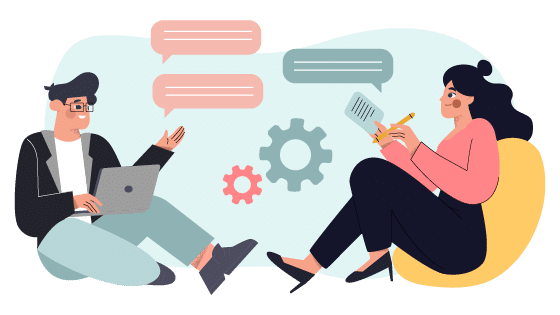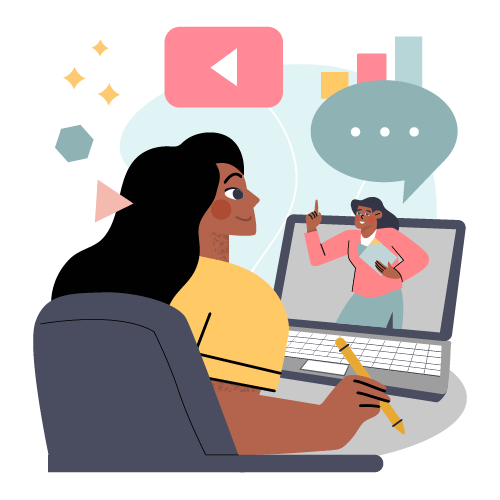Immersive learning is when we learn by doing something ourselves. Interactive learning is when we learn through discussion and interaction with others. It’s vital to learn the reasons behind the existence of immersive and interactive learning approaches, as well as the differences between the two, so that you may determine the strategy that is best for your own training programs.
What is immersive learning?
Immersive learning is a learning modality that replicates real-life scenarios with artificial, digital content and environments to teach and practice new skills. Learners actively shape outcomes inside a risk-free environment for repeated learning and accurate success measurement.
This form of learning, therefore, is precisely what its name implies. It furthers learning objectives by encouraging learners to immerse themselves in learning or submerge themselves fully in the learning environment.
Immersive learning is an active process where learners learn by doing things themselves. They use their own hands, eyes, ears, and other senses to understand concepts and then participate in the learning experience by doing what they’ve learned. Though it may have a unique application in literature or fine arts, this type of learning style is often used in science, technology, engineering, and other applied learning subjects.
Immersive learning involves being fully immersed in what you’re learning. You’ll be able to see, hear, touch, smell, taste, and feel everything related to the subject matter. It’s similar to traditional classroom learning because you’ll be (virtually!) sitting in a room with other students. However, you won’t be interacting with anyone else. Instead, you’ll be using technology to interact with the material and the environment in which that content is presented.
This technological aspect of immersion is critical to immersive learning experiences. In that respect, immersive learning produces much deeper learning than that which occurs in a traditional classroom or in-person setting. For instance, students in an in-class or non-immersive online architecture course may use CAD/CAM software to create a 3D rendition of an architectural structure, like a building, bridge, or dam. They may flip, rotate, and gyrate various views of the structure to get a better feel for their proposed design.
However, an immersive approach might have aspiring architects “step onto” the bridge using Augmented Reality (AR), take a walk on it, and view it from various angles. They may stand on one end of the structure and watch how the columns react when heavy traffic passes over it. An immersive rendition of that same class may potentially have a student sit in a car and drive the length of the bridge while tweaking and changing design parameters to see how those changes impact the design.
While the in-class architecture student can make those same changes and see them reflected as a series of 3D drawings, the immersive learner gets to “live” those changes in as real life as the learning environment can make it feel.
What is interactive learning?
Interactive learning is a learning modality that was a natural evolution from the traditional online, computer-based learning format. In previous evolutions of virtual learning, learners passively consumed static content and then demonstrated their understanding of the content taught via end-of-lesson quizzes and tests.
Interactivity changed the passiveness of learning by encouraging learners to interact with the content, their learner cohorts, and trainers and instructors. It encourages learners to inject their own knowledge and experience of the topic into the learning environment in the form of group chats, moderated discussions, and social media-based learning interactions.
Though more active in its approach than learning with static PowerPoint slides, audio, and text-based content, interactive learning is comparatively, when measured against immersive learning, a more passive form of learning. It involves listening to lectures, reading books, watching videos, and participating in discussions and individual and group activities. This type of learning is often used in business courses.
An example of online interactivity in an eLearning experience might include presenting learners with a problem-definition statement—for instance, developing the ideal marketing strategy in a challenging marketplace. Participants might then indulge in collaborative brainstorming through group chats, online forums, and social media interactions. Individuals may propose segments of the strategy while others may critique, challenge, or reject it, advancing their own strategy components instead.
As a contemporary pedagogical learning approach, interactive learning involves being engaged in an activity where you’re actively participating in the learning process. You’ll be able either to watch others do the work or to complete the task yourself. This type of learning is more effective than passive learning because it allows you to apply what you’ve learned.
Why do we have different learning methodologies?
People learn in a variety of ways, just as they act differently even when doing the same things or activity:
- Visual learners form almost 65 percent of the learning population. These are people who best relate to written content or note-taking and absorb new content best when it’s expressed as graphics, diagrams, and pictures.
- Auditory learners make up roughly 30 percent of the population. These individuals learn best through the spoken word. They prefer to listen to lectures, and even when they have transcripts of learning content, they thrive when they hear those notes “spoken” to them in audio form.
- And finally, there are tactile/kinesthetic learners. These are people who thrive through hands-on learning. They prefer learning through touch and feel, and they master skills through practice and imitation.
In short, some learners prefer to listen while others prefer to read. Some people learn better when they see something with their own eyes, while others learn better by hearing what someone else has to say. The most effective learning modalities take these differences into account when producing learning programs. Different learning methodologies are therefore necessary to cater to different learning styles.
There are also differences between immersive and interactive learning. Immersive learning requires learners to actively participate in the learning process. Immersive learning environments facilitate learning by doing—like entering an operations theater, stepping into the surgeon’s role, and performing a complex procedure on a patient. Interactive learning, on the other hand, allows participants to passively absorb information through lectures, readings, and discussions.
Learners may then demonstrate a comprehension of their understanding through interactions—such as group projects, discussions and debates, and joint exercises—with others in the learning environment.
How does this affect our training programs?
Immersive learning is often seen as more effective than interactive learning because it forces us to pay attention to and focus on the material being taught. When learners know they’ll be asked to “step into” a learning environment and immerse and involve themselves in learning activities, it results in deeper learning and more impactful knowledge transfer to the real world. Because learners simulate and practice what they’re being taught, it helps us understand concepts better and to retain them longer.
While not affording the same level of “hands-on learning” or “learning by doing” as immersive learning, interactive training results in better learning outcomes than wholly passive learning modalities.
For example, having the ability to “bounce ideas” off of a Facebook network of learners about learning concepts results in richer learning outcomes than is possible from reviewing lesson notes and then appearing for a quiz or test. Because it is a less complex learning modality than immersive learning, however, interactive learning is easier to do and is often used as an alternative to immersive learning.
How can you apply these concepts to your organization?
Immersive learning is ideal for students who need to learn something new quickly. It is also a great training modality to deploy when you need learners to safely learn a difficult or dangerous skill—like bomb disposal or how to surgically implant a cardiac device into a patient. They can use it when they’re studying for exams or preparing for job interviews.
If you’re looking to improve your skills, then immersive learning will help you understand the concepts better and retain them longer. Immersive learning also offers a cost-effective way for learners to fail and to learn from their failures without serious consequences,
Interactive learning is ideal for people who prefer to learn at their own pace. They can use it while doing other things such as watching TV or playing games. This type of learning style also works well with people who are self-motivated and enjoy learning by themselves. A learner might, for instance, interact with the learning environment and choose specific paths to a learning simulation. Those interactions may then lead them down a different pathway to unlock additional learning.
Producing effective learning outcomes
Compared to traditional learning modalities, applying the concepts of interactive and immersive learning produces more effective learning outcomes. They deliver the following benefits, among a host of others, to the organization:
- Enhanced learning experiences
- Ability to unleash the power of microlearning content
- Better engagement by leveraging video and animated resources
- Tapping into the power of gamification principles to make learning more engaging
- Using Virtual Reality (VR), Augmented Virtual Reality (AVR), and simulations to help learners better practice and participate in learning environments
If you wish to explore opportunities for interactive and immersive learning within your organization, feel free to contact us. We’ll be happy to discuss your needs and highlight other opportunities that these learning modalities present for your employees.






